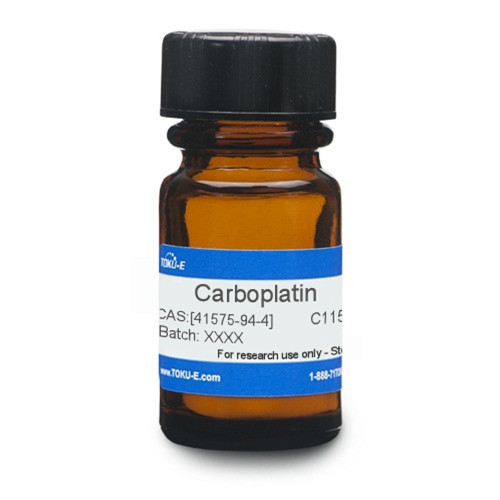Carboplatin, a cisplatin analog, is a platinum-based antineoplastic chemotherapeutic agent that has been used in cancer research including in vitro studies on lung, neck, breast, and cervical cancers. It was co-developed by Bristol Myers Squibb and the Institute of Cancer Research. Cisplatin reacts with silver nitrate and then cyclobutane-1,2-dicarboxylic acid to form carboplatin.
Carboplatin is very slightly soluble in acetone and alcohol but sparingly soluble in water.
| Mechanism of Action | Carboplatin is thought to interfere with DNA repair and has a similar mechanism of action as cisplatin. Carboplatin's main target is DNA and it inhibits replication and transcription and induces cell death. The nature of these DNA adducts influences many transduction pathways thereby triggering apoptosis or necrosis in tumor cells. The adducts can be monoadducts or intra and interchain diadducts. |
| Cancer Applications |
Carboplatin can be used to study its effects on various cancer cell types. The anticancer activity of cisplatin was discovered in the early 1960s by Barnett Rosenberg at the University of Michigan (de Sousa, 2014. He applied an electric field via platinum electrodes immersed in an E. coli solution and noted cells did not divide normally but rather showed filamentous growth up to 200 times above normal. This was related to the electrolysis of the platinum electrodes. After chemical analysis, several platinum complexes were found to induce this behavior. The bivalent complex cis-[Pt(NH3)2Cl2] was active but the trans isomer was much less active. Resistance to Carboplatin and other platinum-basead compounds in epithelial ovarian cancer (EOC) was studied. One mechanism of chemoresistance includes overexpression of pro-survival proteins called inhibitors of apoptosis (IAP) which enable cancer cells to evade apoptosis. IAP proteins area potential target for anticancer methods. A 3D organoid bioassay was used as a preclinical tool to assess the response to chemotherapy or targeted therapies in ovarian cancer. Results showed that carboplatin with birinapant could target a subset of ovarian cancer cell lines. Birinapant is a promising IAP protein antagonist (Singh et al, 2022). |
| Molecular Formula | C6H12N2O4Pt |
| Solubility | Sparingly soluble in water. Very slightly soluble in acetone and alcohol. |
| Impurities | Individual Impurities: ≤0.1% Total Impurities: ≤0.5% |
| References |
de Sousa GF, Wlodarczyk SR and Monteiro G (2014) Carboplatin: Molecular mechanisms of action associated with chemoresistance. Rao RD (2006) Combination of paclitaxel and Carboplatin as second-line therapy for patients with metastatic melanoma. Cancer 106 (2):375-382 Singh T, Neal A, Dibernardo G, Raheseparian N, Moatamed NA and Memarzadeh (2022) Efficacy of Birinapant in combination with Carboplatin in targeting platinum-resistant epithelial ovarian cancers. Int. J. Oncol. 60(3): 35 |



